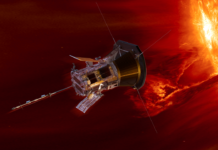NASA’s Parker Solar Probe Achieves Record-Breaking Sun Encounter
In an extraordinary feat of engineering and scientific ambition, NASA’s Parker Solar Probe has accomplished a remarkable milestone by making its closest approach to the Sun on December 24, 2024. This daring mission has set a new record by skimming just 3.8 million miles above the solar surface, surpassing its previous achievements. The spacecraft navigated through the Sun’s outer atmosphere, known as the corona, at an astonishing speed of 430,000 miles per hour, making it the fastest human-made object in history.
A Journey into the Unknown
The Parker Solar Probe’s mission is one of unprecedented exploration and discovery. Launched in 2018, the spacecraft was designed to withstand the intense heat and radiation of the Sun’s vicinity. Its primary objective is to study the solar corona, the outermost part of the Sun’s atmosphere, which is hotter than the solar surface itself. The data collected during these close encounters will provide invaluable insights into solar phenomena, such as solar winds and magnetic fields, which have a direct impact on space weather affecting Earth.
Engineering Marvel: Surviving the Solar Inferno
The success of the Parker Solar Probe is a testament to the ingenuity and dedication of NASA’s engineers and scientists. The spacecraft is equipped with a revolutionary heat shield made of carbon-composite materials that can withstand temperatures exceeding 2,500 degrees Fahrenheit. This heat shield, known as the Thermal Protection System, is a critical component that enables the probe to get closer to the Sun than any previous spacecraft.
In addition to its heat-resistant technology, the probe is outfitted with a suite of scientific instruments designed to measure electric and magnetic fields, plasma waves, and energetic particles. These instruments are shielded and strategically placed to ensure they remain operational in the extreme conditions near the Sun.
Scientific Goals: Unveiling Solar Mysteries
One of the primary scientific goals of the Parker Solar Probe is to enhance our understanding of the solar wind. The solar wind is a stream of charged particles released from the Sun’s upper atmosphere that travels through the solar system. Understanding this phenomenon is crucial because it influences space weather, which can affect satellite communications, GPS systems, and power grids on Earth.
Another significant aspect of the mission is to study the Sun’s magnetic fields. These fields are responsible for solar flares and coronal mass ejections, which are massive bursts of solar material that can disrupt electronic systems on Earth. By studying these magnetic fields up close, scientists hope to better predict and mitigate the effects of such solar events.
Implications for Future Space Exploration
The Parker Solar Probe’s achievements set the stage for future deep space exploration missions. By proving that a spacecraft can survive and operate in the harsh environment close to the Sun, NASA has opened new possibilities for exploring other celestial bodies with extreme conditions. The lessons learned from this mission will inform the design and development of future spacecraft, potentially leading to new missions to the outer planets or even interstellar space.
Advancing Our Understanding of the Sun
The data gathered by the Parker Solar Probe will be invaluable for scientists studying the Sun and its influence on the solar system. By providing a closer look at the solar corona and the dynamics of the solar wind, the probe will help answer fundamental questions about the nature of our star. This knowledge will not only enhance our understanding of the Sun but also improve our ability to predict and prepare for space weather events.
Public Accessibility and Engagement
NASA has made it possible for the public to engage with this groundbreaking mission by sharing videos and data from the Parker Solar Probe. These resources are available for free download and can be accessed from NASA’s official multimedia platform. By making this information accessible, NASA aims to inspire a new generation of scientists and engineers and foster a greater appreciation for space exploration among the general public.
The Road Ahead: Continued Exploration
As the Parker Solar Probe continues its mission, it will make several more close approaches to the Sun, each bringing it closer to the solar surface. These future encounters will provide even more detailed data, further expanding our understanding of the Sun’s behavior and its impact on the solar system. The mission is expected to continue until at least 2025, with the possibility of extending its operations if the spacecraft remains in good condition.
The Parker Solar Probe’s record-breaking journey to the Sun is a testament to human curiosity and innovation. It represents a significant leap forward in our quest to understand the universe and demonstrates the incredible capabilities of modern space exploration technology. As we await new discoveries from this mission, we are reminded of the endless possibilities that lie ahead in our exploration of the cosmos.
For more detailed insights and updates on the Parker Solar Probe and its mission, visit NASA’s dedicated mission page at [NASA Parker Solar Probe](https://svs.gsfc.nasa.gov/14741).
For more Information, Refer to this article.



































